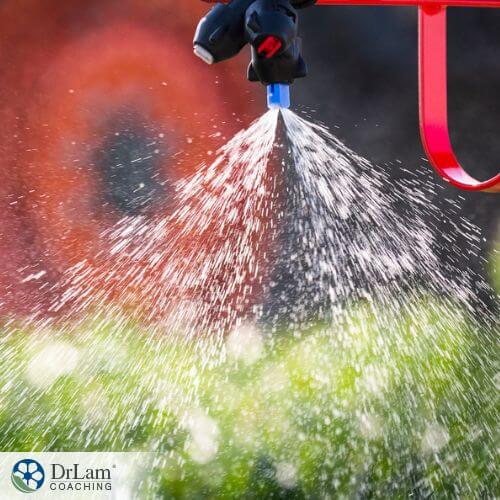Water is essential for life. And that is why polluted water can be a big problem. Atrazine is a herbicide that kills weeds. It can flow into water sources. As a result, it can potentially cause harm when you drink it. It can have serious effects on people, animals, and the environment, and it is present in most water sources in the US.
 Atrazine is an artificial chlorotriazine developed in 1958. Many products contain it for clearing crop fields, golf courses, lawns, or gardens of weeds. Farmers use it after harvesting wheat, corn, sugarcane, or sorghum. Moreover, you can be exposed to it through water, soil, and air.
Atrazine is an artificial chlorotriazine developed in 1958. Many products contain it for clearing crop fields, golf courses, lawns, or gardens of weeds. Farmers use it after harvesting wheat, corn, sugarcane, or sorghum. Moreover, you can be exposed to it through water, soil, and air.
It can travel as runoff to streams and into waterways. This case is most alarming since it can flow to drinking water sources. The USDA detected it in 89.2% of drinking water as of 2012. It's most prevalent in the Midwest due to its use for crops.
You can also be exposed to contaminated soil while digging in the dirt or inhaling it near an area where people use it. Some foods also contain traces of the chemical, but the residue is not toxic enough to cause harm.
There are ways to lessen atrazine in water. One study, conducted by Dr. Patrick Drogui and team found that a process called photo-electron-Fenton (PEF) effectively removed it from the surface of waters near agricultural areas. However, more processes need to be developed to effectively keep it out of drinking water.
Over time, atrazine disrupts your endocrine and reproductive functions. Research has also found it to increase the risk of prostate cancer in men and breast cancer in women. It has been connected to cancer in children and to fetal malformations and preterm birth.
The endocrine system consists of hormones regulating various functions that include metabolism and growth. Sexual and emotional processes are also involved. The reproductive system also produces hormones and plays a major role in pregnancy and childbirth.
Studies show atrazine is an endocrine-disrupting agent.
One study, published in Acta Pediatrica (1992), found agrichemicals may have caused birth abnormalities in the US. Moreover, a study by Waller et al. (2010) shows fetal gastroschisis was linked to mothers who were exposed to it. This is a condition where the baby’s intestines protrude from the belly button. Studies have also connected the chemical with an increased risk of miscarriage, preterm birth, low birth weight, and lowered male fertility.
A study on mice shows that prenatal exposure induced sexual organ defects in the male offspring. These defects, called cryptorchidism and hypospadias, can cause infertility. Studies on frogs found males exposed to the chemical developed female-like characteristics that made them infertile.
Short- and long-term exposure can cause liver problems. For example, it damaged mitochondria resulting in changes in muscle and the liver (Sagarkar et al., 2016). Another study, in which pregnant mice received drinking water with atrazine, found the male offspring had lower liver weight than usual. They further discovered a change in genes involved in lipid metabolism in the liver.
Studies on female rats showed an increase in mammary tumors following atrazine exposure, but it is uncertain whether this could translate to humans.
You can either inhale, touch, drink, or eat it. Generally, initial symptoms are mild. Exposure to it shows symptoms such as:
There are specific lab tests to detect it in blood, breast milk, fat, and semen. Atrazine is excreted from your body within 24-48 hours. Thus, these tests cannot detect past exposures. Long-term exposure is not easily observable. The symptoms depend on the organs affected by chronic exposure. It is best to talk to a medical provider for a thorough check-up.
Apply first aid when consumed, inhaled, or if it gets to the eyes or onto the skin. The National Toxicology Program suggests the following actions:

If you have been exposed to atrazine, you may need detoxification. Several antioxidants may be used to help deal with toxicity effectively, according to studies.
Vitamin E, an antioxidant, has protective effects as it lessens toxicity.
Another antioxidant, selenium, showed protective action on the liver. A study on rats found that selenium had a protective effect on the liver when they were exposed to toxins.
Spirulina, as an antioxidant, protects against oxidative stress. Two studies by Khalil et al. (2017) and Toughan et al. (2017) found that freshwater carp exposed to atrazine had less liver injury and inflammation. Moreover, the researchers suggest using it to maintain immune function.
Studies show atrazine increases oxidative stress and free radicals. As a result, they damage your cells, causing inflammation. Inflammation is your body’s way of launching an attack against toxins. But chronic inflammation can develop into various health problems. For example, it can injure your liver and kidneys.
Atrazine can cause short- or long-term inflammation. For instance, you can easily see short-term inflammation in the affected area. There’s redness, swelling, and itchiness or pain. It can happen to your eyes and skin when exposed to it. You can also experience coughing or breathing difficulties when you inhale it.
In contrast, long-term inflammation happens when you are regularly exposed to it. This can have long-term effects on your endocrine system and reproductive system, as noted above, which also leads to inflammation.
Atrazine affects the Inflammation Circuit of the NeuroEndoMetabolic Stress Response. The Inflammation Circuit combats stressors through a healthy immune system.
It does not accumulate in your body. But continued exposure to it causes stress in your body.
The adrenal glands on top of your kidneys release cortisol and stress hormones. So if your body continues to deal with atrazine on an ongoing basis, it results in a rise in stress hormones. Eventually, your adrenals can get overworked, leading to adrenal fatigue and other health conditions.
People can be exposed to this weed-killing herbicide. It can either be consumed, touched, or inhaled without your knowledge. Its harmful effects can be temporary. But it can also cause chronic problems, especially to your endocrine system, your reproductive system, and to developing babies. Toxicity can lead to inflammation, which can lead to many health problems.
If you suspect chronic atrazine exposure, call us for a free consultation. Members of Dr. Lam Coaching Team are available to talk to you at +1 (626) 571-1234.
Atrazine is a weed-killing herbicide that can find its way into drinking water. If you get exposed, you can experience minor discomfort. But chronic exposure can result in inflammation that leads to many health problems.
